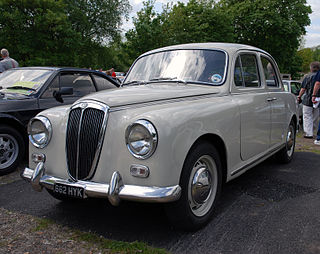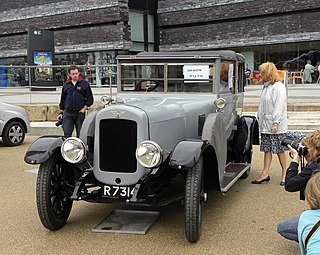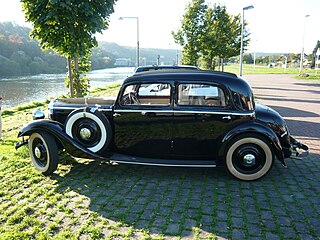
The Chrysler Imperial, introduced in 1926, was Chrysler's top-of-the-line vehicle for much of its history. Models were produced with the Chrysler name until 1954, after which it became a standalone brand; and again from 1990 to 1993. The company positioned the cars as a prestige marque to rival Cadillac, Continental, Lincoln, Duesenberg, Pierce Arrow, Cord, and Packard. According to Antique Automobile, "The adjective ‘imperial’ according to Webster's Dictionary means sovereign, supreme, superior or of unusual size or excellence. The word imperial thus justly befits Chrysler's highest priced model."

The Lancia Fulvia is an automobile produced by Lancia between 1963 and 1976. Named after Via Fulvia, the Roman road leading from Tortona to Turin, it was introduced at the Geneva Motor Show in 1963 and manufactured in three variants: Berlina 4-door saloon, 2-door Coupé, and Sport, an alternative fastback coupé designed and built by Zagato on the Coupé floorpan.

The Mercedes-Benz W189 model 300 was a four-door luxury tourer produced by Mercedes-Benz between 1957 and 1962. It was the company's flagship model at the time, equivalent to the modern S-Class and Maybach.

The Mercedes-Benz W186 Model 300 was a four-door luxury sedan produced by Mercedes-Benz between 1951 and 1957. It was the company's flagship model at the time, succeeding the World War II era W150. Three versions were produced in succession, known informally as the 300a, 300b, and 300c. An enlarged "300d" variant built on the W189 chassis succeeded it in late 1957.

The Lancia Appia was a passenger car introduced in 1953 by Italian car manufacturer Lancia as a replacement for the Ardea, and which remained in production for ten years. The Appia was the last in a long line of Lancia production cars dating back to the Lancia Lambda to use the famous sliding pillar front suspension. All three series produced had a Lancia V4 engine of 1089 cc.

The Lancia Artena is a passenger car produced by Italian car manufacturer Lancia from 1931 to 1936, and from 1940 to 1942 chiefly for army and government use. It was powered by a 2-litre Lancia V4 engine, while chassis and factory bodies were shared with the more luxurious 2.6-litre V8-engined Lancia Astura. Total production amounted to 5,567 examples.

The Lancia Dikappa is a passenger car produced by Lancia between 1921 and 1922. It was a factory-offered sport version of the Kappa model, with overhead valves and a lighter body. 160 were made in the two years of production.

The Lancia Kappa is a passenger car produced by Lancia between 1919 and 1922. Lancia's first post-war model, it was an updated version of the earlier Theta. 1,810 were made in total, surpassing the Theta as the best-selling Lancia motor car at the time.

The Lancia Trikappa is an automobile produced by Lancia between 1922 and 1925. It was a luxury car, the flagship of Lancia's production. The Trikappa 4.5-litre V8 is notable as the first of Lancia's narrow V engines, a distinguishing feature the manufacturer only abandoned in the 1970s. The car was offered as a bare rolling chassis, as torpedo or 6-seater coupé de ville. In total 847 were manufactured.

The Lancia 20 HP, later renamed Lancia Gamma, is a passenger car produced by the Italian car manufacturer Lancia during 1910. It was derived from a previous Beta model, now equipped with a bigger engine. In total, 258 units were built. In 1911, the type was superseded by the larger-engined and more powerful Lancia 20-30 HP Delta.
The Lancia 20-30 HP, later renamed Lancia Delta, is a passenger car produced by Italian car manufacturer Lancia during 1911. The Delta was based on the earlier 20 HP Gamma, with an enlarged engine. 303 Deltas were made in total, before it was replaced by the improved 20-30 HP Epsilon.

The Cunningham automobile was a pioneering American production automobile, one of the earliest vehicles in the advent of the automotive age. It was produced from 1896 to 1931 in Rochester, New York by James Cunningham, Son and Company.

Austin Twenty is a large car introduced by Austin after the end of the First World War, in April 1919 and continued in production until 1930. After the Austin 20/6 model was introduced in 1927, the first model was referred to as the Austin 20/4.
The Lancia Ro, Lancia Ro-Ro and Lancia 3Ro were 4x2 heavy trucks built by Italian manufacturer Lancia from the 1930s through the 1940s for military and civilian use. The 2-cylinder diesel Ro was produced from 1933 to 1939, the 3-cylinder diesel Ro-Ro from 1935 to 1939 and the improved 5-cylinder diesel 3Ro from 1938 to 1947.

The Packard Motor Car Company introduced their first four-cylinder engine in 1903 initially as a top level car along with the Packard Model F. It was their only automobile offered and exclusively used a four-cylinder engine from 1903 until 1912 and established Packard as a luxury car maker, and was replaced by the 1913 Packard Six.

The Lancia Jota is a series of truck and bus chassis produced by Lancia between 1915 and 1935. The original 1915 Jota was the first true Lancia truck; throughout the following two decades it was made in a number of different series and variants, each identified by a progressive Greek numeral prefix added to the name, from Djota to the last Eptajota. While axle tracks, wheelbase and equipment gradually grew, the original layout and 4,940 cc four-cylinder petrol engine were retained.

The Mercedes-Benz W 21 was a six-cylinder passenger car launched in 1933 using the name Mercedes-Benz Typ 200. It was one of several Mercedes-Benz models known, in its own time, as the Mercedes-Benz 200 and is therefore in retrospect more commonly referred to using its Mercedes-Benz works number, “W21”.

The Mercedes-Benz W 142 was a six-cylinder passenger car launched in February 1937, as a successor to the Mercedes-Benz Typ 290. The car was known by its name Typ 320 at the time of its production and service, but is in retrospect commonly referred to using its Mercedes-Benz works number, "W142", which gives a more unambiguously unique nomenclature.
The Lancia 12 HP, later known as Lancia Zeta, is a passenger car produced by Lancia between 1912 and 1914. It was intended to be Lancia's smaller offering, positioned below the 4-litre 20/30HP Delta and Epsilon models. The Zeta did not prove a success, and production is estimated at just 34 examples ; none have survived.
The Lancia 1Z was a light military truck produced by Italian manufacturer Lancia between 1912 and 1916. From a mechanical standpoint, it was closely related to the 1913 35 HP Theta passenger car. It was Lancia's first military vehicle.
















